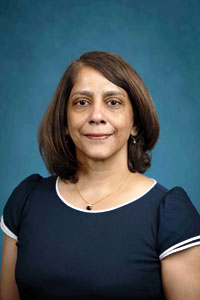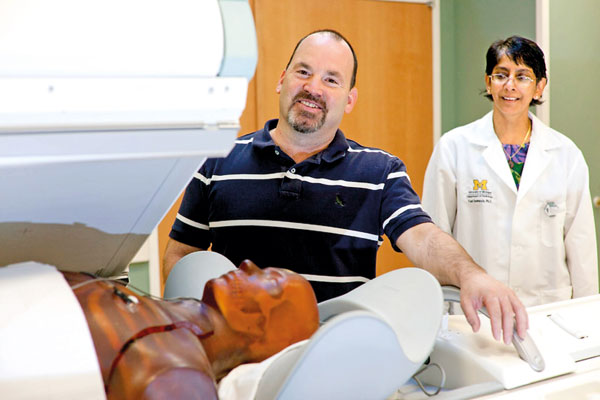News
Tailoring treatment for each cancer patient with a ‘code’
View(s):- Major achievement by Medical Physicist Dr. Yuni Dewaraja of Sri Lankan origin
By Kumudini Hettiarachchi
Tomorrow (June 23), Medical Physicist Dr. Yuni Dewaraja, who was born in Sri Lanka, lived and worked here till 1986, stands before her peers in America to deliver the prestigious 2025 Hal Anger Lectureship titled ‘Molecular Vision, Targeted Precision’ at the plenary session of the SNMMI Annual Meeting in New Orleans, Louisiana, the United States of America.
She will highlight a ‘code’ that will take precision medicine to the bedside of men, women and children ravaged by cancer.
Before we get into the technical intricacies, when asked about the huge benefits for people through the ‘dosimetry code’ in the future, Dr. Dewaraja says that conventionally, radiopharmaceutical therapies are delivered on a ‘one size fits all basis’. This means that the amount of radioactive material and the number of cycles of the treatment are the same for all patients, regardless of size and biology. This can lead to under-treatment and over-treatment.
“Therefore, coupling nuclear medicine imaging and personalised dosimetry calculations, there is potential to tailor the treatment for each patient, to administer just the right amount of the radiopharmaceutical to treat their cancer, while keeping the radiation to their healthy organs below toxicity limits,” she explains.

Dr. Yuni Dewaraja
‘Where Groundbreaking Research Meets Clinical Innovation’ is the theme of the meeting of the SNMMI—the North American Society of Nuclear Medicine and Molecular Imaging, a non-profit scientific and professional organisation that promotes the science, technology and practical application of nuclear medicine and molecular imaging.
Described by SNMMI as a “distinguished leader” in quantitative imaging and dosimetry, Dr. Dewaraja, the William Martel Endowed Professor of Radiology at the University of Michigan, has more than 25 years of research experience in nuclear medicine therapy.
“Success in my research would not have been possible without the collaborations I have with many talented colleagues at the university and the work of dedicated graduate students,” said Dr. Dewaraja in an email interview with the Sunday Times, explaining that the Hal Anger Lectureship and Award is “rewarding”, considering that Hal Anger is the inventor of the gamma camera, also known as the Anger camera in SPECT (Single Photon Emission Computed Tomography) imaging used in much of her research.
Asked about the ‘dosimetry code’, Dr. Dewaraja explains that early in her career, she was able to secure funding from the National Institutes of Health (NIH) to develop methods for personalised dosimetry calculations in nuclear medicine therapies.
“Our early research focused on radioimmunotherapy, where antibodies labelled with radioactive iodine (I-131) target and destroy non-Hodgkin’s lymphoma cells. We developed software to perform these calculations in a highly personalised manner starting with the patient’s own images,” she said.
Explaining the technicalities, she says, “The inputs to the calculation are positron emission tomography (PET) or SPECT images, which show how the radiotracer is distributed in the body and Computer Tomography (CT) images, which provide the density of the different tissues. Starting with these images, we used the Monte Carlo method to simulate how the radiation is transported in the body. The Monte Carlo method is a numerical technique used in many fields for solving statistical problems.

Dr. Dewaraja and a colleague perform an experiment with the SPECT scanner, using what is called a ‘phantom’, which is filled with radioactive solution to mimic a patient scan
“Over the years, we further developed our code, Dose Planning Method for Radiopharmaceutical Therapy (DPM_RPT), to expand its use in other therapies. This included Lu-177 peptide receptor radionuclide therapy for neuroendocrine tumour; Lu-177 PSMA radioligand therapy for prostate cancer; and Y-90 radioembolisation, where radioactive microspheres are implanted in liver tumours.”
Dr. Dewaraja and her team had worked with the code for over 20 years, adding new features and carefully validating the calculations, including comparison with experimental measurements.
Referring to one of the main challenges, she says it was to make the calculations fast enough for the clinic environment because Monte Carlo methods are computationally demanding. “When we were using the code for research, the time to run a calculation was not a big problem, but to translate to the clinic, speed is very important.”
Then four years ago, Dr. Dewaraja received an Academic Industry Partnership grant from NIH—the goal was to translate academic research and tools into clinical practice.
Working with the technology transfer office of the University of Michigan, she and her team had licensed DPM_RPT to GE Healthcare’s MIM Software. The code was recently approved by the Food and Drug Administration (FDA) to be marketed in the USA.
To streamline the process, DPM_RPT has been coupled with other tools required for dosimetry, including Artificial Intelligence (AI) to segment organs on the patient images, says Dr. Dewaraja, pointing out that it is very rewarding to see all the parts come together to make an efficient and automated dosimetry pipeline.
(Visit PLUS section for
Dr. Yuni Dewaraja’s profile)
| Will take time for advances in radiopharmaceutical therapy to reach SL
Some of the radiopharmaceutical therapies were only recently approved for clinical use in the US, Australia and some countries in Europe and Asia. Dosimetry-guided adjustment of these treatments requires additional training, resources and collaboration between doctors and medical physicists, says Dr. Yuni Dewaraja, when asked when countries like Sri Lanka would benefit. “Unfortunately, it will take time for advances in radiopharmaceutical therapy to make it to clinical practice in developing countries,” she says, but gives hope when she points out that organisations like the International Atomic Energy Agency (IAEA) are actively working on providing resources and training medical physicists in developing countries in anticipation of the future. She adds, “I am involved in some of these projects. Recently I co-edited the textbook for medical physicists on ‘Dosimetry for Radiopharmaceutical Therapy’, published by the IAEA, which is available freely for download.”
This valuable link is: https://www-pub.iaea.org/MTCD/Publications/PDF/p15002-PUB2065_web.pdf | |
The best way to say that you found the home of your dreams is by finding it on Hitad.lk. We have listings for apartments for sale or rent in Sri Lanka, no matter what locale you're looking for! Whether you live in Colombo, Galle, Kandy, Matara, Jaffna and more - we've got them all!

